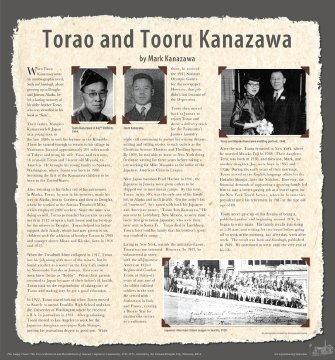|
Description
|
| Torao and Tooru Kanazawa by Mark Kanazawa When Tooru Kanazawa wrote his autobiographic novel, Sushi and Sourdough, about growing up in Douglas and Juneau, Alaska, he left a lasting memory of his older brother Torao, who was identified in his book as "Ken". Their father, Matajiro Kanazawa left Japan as a young man in the late 1880's to seek his fortune in the Klondike. There he earned enough to return to his village in Yonezawa (located approximately 205 miles north of Tokyo) and bring his wife, Yaso, and two sons, 16 year-old Torao and 14-year old Miyoshi, to America. He brought his young family to Spokane, Washington, where Tooru was born in 1906 becoming the first of the Kanazawa children to be born in the United States. After listening to his father tell of his adventures in Alaska, Torao, by now in his twenties, made his way to Alaska, first to Cordova and then to Douglas, where he worked at the famous Treadwell Mine, which employed 2000 workers. Since the mine was doing so well, Torao persuaded his parents to come north in 1912 to open a bath house and barbershop for the miners in Douglas. Torao helped his father support their family, which had now grown to six children with the addition of brother Tetsuo in 1908 and younger sisters Misao and Kiyoko, born in 1910 and 1912. When the Treadmill Mine collapsed in 1917, Torao lost his job along with most of the miners, but he found another as a waiter at the City Cafe owned by Shonosuke Tanaka in Juneau. Everyone in town knew Torao as "Bobby". When their parents returned to Japan because of their father's ill health, Torao took on the responsibility of taking care of Tooru and making sure he got a good education. In 1922, Torao stayed behind when Tooru moved to Seattle to attend Franklin High School and then the University of Washington where he received a B.A. in journalism in 1931. After graduating, Tooru moved to Los Angeles to work for the Japanese-American newspaper Rafu Shimpo, putting his journalism degree to good use. While there, he covered the 1932 Summer Olympic Games for the newspaper. However, that job didn't last because of the Depression. Tooru then moved back to Juneau to rejoin Torao and drove a delivery truck for the Fukuyama's Juneau Laundry while still continuing to pursue his writing dreams, writing and selling stories to such outlets as the Christian Science Monitor and Thrilling Sports. By 1939, he was able to move to New York doing freelance writing for three years before taking a job working for Mike Masaoka at the office of the Japanese American Citizens League. After Japan bombed Pearl Harbor in 1941, the Japanese in Juneau were given orders to be shipped out to internment camps. By this time, Torao, in his 50's, was the only one of his family left in Alaska and in ill health. On the army's list of "internees", he's noted with both his Japanese and American names, "Torao Bob Kanazawa," He was sent to Lordsburg, New Mexico, as were most isseis (first generation Japanese) who were then later sent to Santa Fe. Torao died in Lordsburg. Tooru later told his family that his brother's spirit was crushed in camp. Living in New York, outside the militarized zone, Tooru was not interned. However, In 1943, he volunteered to serve with the all-Japanese American 442nd Regimental Combat Team, at thirty-six years of age, one of the oldest enlisted soldiers in the unit. He served with distinction in Italy and France, earning a Bronze Star for meritorious service as a radioman. After the war, Tooru returned to New York, where he married Masako Fuji in 1948. Their daughter, Teru, was born in 1950, and then son, Mark, and another daughter, Joy, were born in 1955 and 1958. During the early years of their marriage, Tooru served as the English language editor for the Hokubei Shimpo, later the Nichibei. However, the financial demands of supporting a growing family led him to take a better-paying job as a travel agent for the New York Travel Service, where he became vice president until his retirement in 1987 at the ripe old age of 80. Tooru never gave up on his dreams of being a published author and beginning around 1970, he began to write again. His family recalls him rising at 5:30 a.m. and writing for two hours before going off to work in the morning, day after day, week after week. The result was Sushi and Sourdough, published in 1989. He continued to write until the very end of his life. Image Captions (All images provided by the Kanazawa Family.): Tooru and Masaka Kanazawa wedding portrait, 1948. Tooru Kanazawa in 442nd Uniform, 1944 Torao Kanazawa. Japanese American Citizen League in Seattle, 1930 |
Torao and Tooru Kanazawa Panel
-The Empty Chair: The Forced Removal and Relocation of Juneau's Japanese, 1941-1951
-Permission to use this image may be obtained by contacting museum staff.

All images are the property of the Juneau-Douglas City Museum. No image may be copied, downloaded or reproduced without the express permission of the Juneau-Douglas City Museum.

All images are the property of the Juneau-Douglas City Museum. No image may be copied, downloaded or reproduced without the express permission of the Juneau-Douglas City Museum.